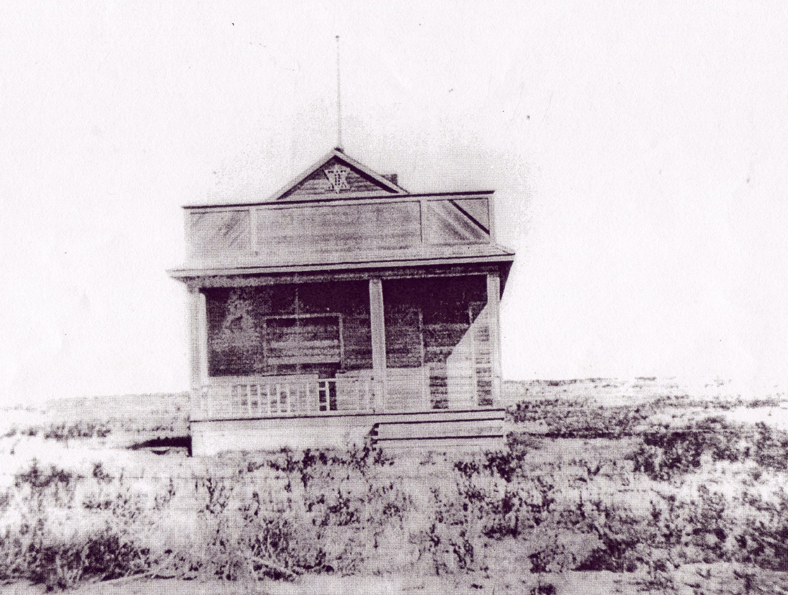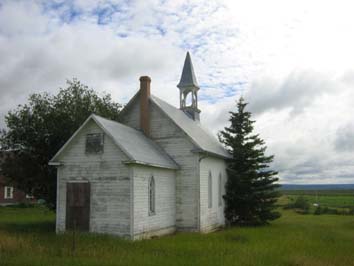
a solo exhibition by Simon Wroot
Three Churches Loved
Prairie Echo
St. Antoine’s Mission Farm Church
|
|
In 1899 the Anglican church started a mission and school on the Heart river where it flows into Buffalo Bay. To counter this Fr. Alphonse Demerais of the Oblates of Mary Immaculate, with help from local Metis and Slavey’s secretly cut and squared logs that winter, and by Sept 1890 opened a Catholic mission chapel and school. This was operated by Br. Patrick Ryan. Initially called Heart river Mission, it was blessed with High Mass and the Sacrement of confession by Bishop Grouard from the nearby St. Bernard’s Mission. In Sep. 1894 the school closed, but mass continued to be celebrated every Sunday. On Sep 14th, 1895, the Mission was dedicated to St. Antoine in honour of Fr. Joseph Antoine who was visiting at the time. It then became the farm for the larger mission at St. Bernard’s, soon to be the settlement of Grouard. In 1902 the chapel burned to the ground, and was replaced in 1906-07 with the present building. In 1937 Lucien Lizee, who had worked at the farm and for the larger Mission , was given a lease to buy the farm which he managed to do in 11 years. In 1942 the original Mission house burned down, and was replaced with the existing building. The farm and church stayed in the Lizee family, and services were held regularly by a Roman Catholic priest until 1994. The Church is now no longer kept up, but the interior is still a beautiful sky blue, and the pews are there, ready for the faithful to return. The Lizee family still hopes to restore it. The Cemetery, with graves dating from Jan. 30 1897 to Jan. 18 1997 is up on the hill behind the church, looking down over Buffalo Bay. These and the house are the only remnants of a once prosperous mission farm, and a commitment to a life of faith.
Hillcrest
Hillcrest United Church, 1914
This church was built on land belonging to C.P Hill, owner of the Hillcrest Mine, and apparently donated to the people. It was built by the miners, with donations of time and materials from the townspeople. Building was started in 1912 by Presbyterian Minister Rev. Laing, but he was sent to Passburg, the church became Methodist, and finally opened in 1914.
 In that year there was a horrendous explosion in the mine and 189 souls perished. A service for 151 was held on main street, accompanied by the local welsh choir (many of the miners were welsh). The remaining services were held in the local churchs over the next couple of weeks. In 1925 the Methodists united with the Presbyterians and Congregationalists to form the United Church. The church was completely re-furbished by volunteers in the late 1980s. It was jacked up and moved back to allow digging a basement, but at one point it fell off its pilings and damaged one corner. The steeple broke and needed replacing, and the interior required renovating, but the miners were concientious builders and created a solid structure that was not damaged. Even though the church had just been re-furbished and had a thrving and energetic congregation, it was closed in 1994-5 by the dioscese in a re-organization of the Crowsnest corridor. It was then sold, and is now under private ownership.
In that year there was a horrendous explosion in the mine and 189 souls perished. A service for 151 was held on main street, accompanied by the local welsh choir (many of the miners were welsh). The remaining services were held in the local churchs over the next couple of weeks. In 1925 the Methodists united with the Presbyterians and Congregationalists to form the United Church. The church was completely re-furbished by volunteers in the late 1980s. It was jacked up and moved back to allow digging a basement, but at one point it fell off its pilings and damaged one corner. The steeple broke and needed replacing, and the interior required renovating, but the miners were concientious builders and created a solid structure that was not damaged. Even though the church had just been re-furbished and had a thrving and energetic congregation, it was closed in 1994-5 by the dioscese in a re-organization of the Crowsnest corridor. It was then sold, and is now under private ownership.
It stands there still, very proudly nestled against the mountain and mourned by it’s congregation. It is a reminder to any passesby of the legacy of the mines, and the strength and committment of the miners who built it, worshiped in it, and were buried from ityears before, by giving both buildings a 3rd life.
Sibbald
Montefiore Colony Synagogue
In the early 1900s, Jewish families were encouraged to come to Albert from Eastern Europe where they could not own land, and were regularly persecuted. A number of Jewish-Russian immigrants came to Alberta and formed farming communities or colonies at Trochu in 1905, Rumsey in 1907, and Muhlback near Sibbald in 1911.
 Abraham Cheterener moved from Bessarabia in 1912 to Muhlback to the Montefiore Colony, named after a well known wealthy Jewish philanthropist who gave money to help Jews immigrate to North America. Abraham dedicated one corner of his homestead for use as a site for a community synagogue. It was built in 1913, and immediately became not only the synagogue, but also the social hall, the school, and there is an oral history of a large library as well. The approximately 20 families at the Colony suffered a great deal, as did many thousands of other settlers, from the droughts of the early 1920s. By 1925 all had left, and moved to be with more successful families in the U.S. The building was abandoned, and eventually sold. It has been moved more than once, and renovated several times as a dwelling.
Abraham Cheterener moved from Bessarabia in 1912 to Muhlback to the Montefiore Colony, named after a well known wealthy Jewish philanthropist who gave money to help Jews immigrate to North America. Abraham dedicated one corner of his homestead for use as a site for a community synagogue. It was built in 1913, and immediately became not only the synagogue, but also the social hall, the school, and there is an oral history of a large library as well. The approximately 20 families at the Colony suffered a great deal, as did many thousands of other settlers, from the droughts of the early 1920s. By 1925 all had left, and moved to be with more successful families in the U.S. The building was abandoned, and eventually sold. It has been moved more than once, and renovated several times as a dwelling.
This lucky, neglected old building is the only known surviving prairie synagogue in Alberta, and it is having a re-birth. A non-profit society of dedicated and enthusiastic volunteers has purchased it. They have formed a partnership with Heritage Park in Calgary, and are currently fund raising to turn it into a historically authentic pioneer synagogue. It will once again do what it was created to do; be a community gathering place, be a house of learning for Park visitors, and possibly celebrate the occasional wedding
